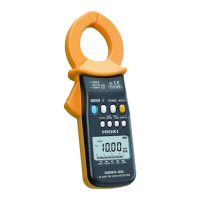27
Measuring Leakage Current
• Do not input current that exceeds the current range's
maximum continuous input.
• Measurement may not be accurate in the cases below.
(1) If there is large current (of about 100 A) owing through a
nearby electric line.
(2) If you use the instrument to measure the waveforms on the
secondary side of an inverter, or other special waveforms.
(3) If the jaws are not fully closed.
In cases where the wires are thick, such as with clamping of a
3-phase cable, always make sure that the jaws are fully closed.
When the jaws are not fully closed, error occurs in the measured
values and accuracy cannot be assured.
• Note that a value of several tens of amperes may be displayed
when the jaws are opened or closed or when the current
range is changed, but this is not an error. Simply wait a little
while for the display to return to zero. Or start measurement
before it returns to zero – there will not be any adverse
effects.
• In cold areas, the display may not go to zero when the jaws are
taken off the conductor. This will not affect accuracy, provided that
you are measuring current of or above the 1 mA that is the bottom
limit of the guaranteed accuracy range.
• This instrument is designed for measuring electricity lines
up to CAT III 300 V (voltage to ground). However, in the
exceptional case of a 3-phase 3- or 4-wire line, or similar
line, whose neutral point is grounded ("Y" connection or star
connection), the instrument can be used on lines of up to 500
V line voltage (approx. 289 V voltage to ground) – but only in
such a case.

